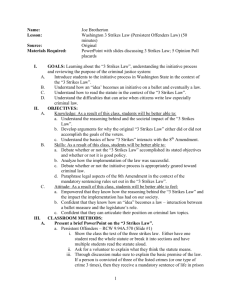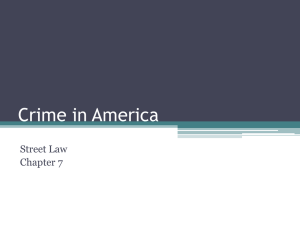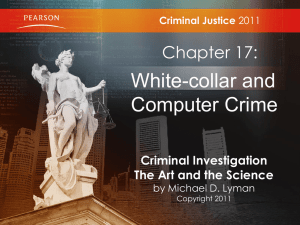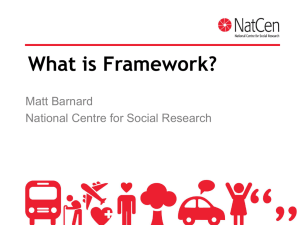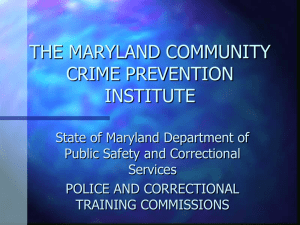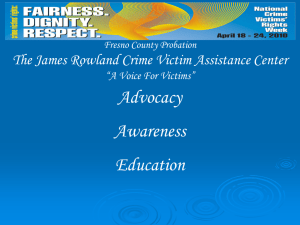Improving Juvenile Justice Policy in California A
advertisement
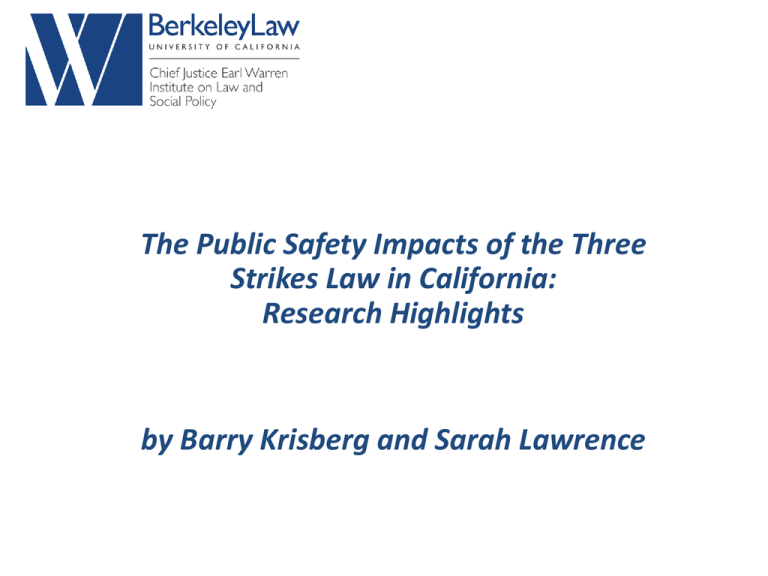
The Public Safety Impacts of Three Strikes in California: The Public Safety Impacts of the Three A Review of the Research Strikes Law in California: Research Highlights by Barry Krisberg and Sarah Lawrence Theories Behind Three Strikes Laws Incapacitation: the removal of offenders from the community makes it physically impossible for them to commit further crimes outside of prison Deterrence: people are discouraged from committing criminal acts out of fear of punishment General deterrence: aimed at the public at large using the threat of punishment Specific deterrence: aimed at individuals based on experience of punishment 2 Examples of Challenges of Research on Three Strikes Establishing cause and effect Compared to what? Estimating number of crimes prevented 3 Prosecutors’ Perspective on California’s Three Strikes Law, by CA DA’s Association, 2004 Includes descriptions of approximately 10 individual cases In one place the report states: “Three Strikes has directly and significantly acted to reduce crime in CA.” In another place the report states: “The dramatic drop in CA crime might be properly attributable to several substantial factors. It is counterintuitive to think that incarcerating violent recidivists as felons…was not one of them.” 4 Prosecutors’ Perspective (cont’d) DA’s did not focus public safety impacts but rather on practical consequences claiming that Three Strikes… has not caused prisons to bankrupt CA has not caused a decrease in education funding has not overcrowded prisons has not required new prisons 5 Still Striking Out: Ten Years of California’s Three Strikes, by Justice Policy Institute, 2004 Report has five key findings, one of which is related to public safety Most strikers in prison for non-violent offenses Law disproportionately impacts African-Americans and Latinos Law has cost taxpayers over $8 billion 46,000 children with incarcerated parent for many more years because of Three Strikes law No evidence of a crime reduction benefit 6 Impacts of Three Strikes and You’re Out on Crime Trends in CA and Throughout US by Elsa Chen, Journal of Contemporary CJ, 2008 Key research question: Did Three Strikes laws have significantly greater effects on crime in California than elsewhere in US? Methods: State-level data for all 50 states from 1986 – 2005 Compared states with and without Three Strikes laws Contrasted California with other states 7 Impacts of Three Strikes and You’re Out (cont’d) Key findings: California’s relatively tough and frequently used law has not resulted in greater incapacitation than other states’ more limited laws California’s law extends beyond point of diminishing marginal returns Statistically significant decreases in motor vehicle theft and robbery in CA suggesting some deterrent effect Essentially no incapacitation effect 8 I’d Rather be Hanged for a Sheep than a Lamb: The Unintended Consequences of Three Strikes Laws by Radha Iyengar, NBER Working Paper, 2007 Key research question: What are the impacts of a sentencing policy with large increases penalties for a wide range of crimes? Methods: Sample of criminal records of individuals arrested during 1990-1999 From Los Angeles, San Francisco, and San Diego 9 I’d Rather be Hanged for a Sheep than a Lamb (cont’d) Key findings: Reduced overall level of crime 20% reduction in criminal activity for second-strike eligible offenders and 28% reduction for third-strike eligible offenders But increased probability of committing violent crime Increase of 9 percentage points for third-strike eligible offenders Increase in migration of criminals with second and third strike eligibility to commit crime in neighboring states 10 The Effect of Three-Strikes Legislation on Serious Crime in California by John L. Worrall, Journal of Criminal Justice, 2004 Key research question: Does Three Strikes legislation reduce violent crime? Methods: County-level data from 1989 to 2000 Controlled for economic, demographic, and deterrence- oriented factors 11 The Effect of Three-Strikes Legislation on Serious Crime in California (cont’d) Findings: Three-strikes had virtually no deterrent effect on serious crime Controlling for trends in individual counties, three strikes had virtually no deterrent or incapacitative effects on serious crime Violent crimes were reduced when more “three-strikers” were committed to prison – in other words, three-strikes incapacitative effect appears to outweigh its deterrent effect No evidence that three strikes causes an increase in certain types of crime 12 Crime and Punishment in California: The Impact of Three Strikes and You’re Out by Zimring et al, Institute of Governmental Studies Press, 1999 Key research question: Was the Three Strikes law responsible for a major share of California’s crime decline? Methods: Analyzed arrests before and after law went into effect Based on data from Los Angeles, San Diego, and San Francisco 13 Crime and Punishment in California (cont’d) Key findings: The potential maximum crime reduction is fairly small Individuals eligible for 3rd strike were responsible for 3.3% of all urban felony arrests and those eligible for a 2nd strike were responsible for 7.3% of arrests – i.e., 90% of criminals not covered People eligible for 3rd strike accounted for 3.3% of arrests before law and 2.7% of arrests after law Three Strikes law reduced crime by 0.6% 14 California Criminal Justice System (Part I Crimes) 2009 Part I Crimes (779,625)1 Adult Part I Arrests (250,653)2 Adult Part I Convictions (96,813)3 Adult Part I Sentenced to Prison (22,314)4 Source: Crime in California, 2009. California Department of Justice. 1Table 1, 2Table 19, 3Table 40, 4Table 41. http://ag.ca.gov. Accessed on May 5, 2011. Share of California Prisoners that are 2nd and 3rd Strikers, 2009 Source: Corrections,Year At A Glance, Fall 2010. California Department of Corrections and Rehabilitation. http://www.cdcr.ca.gov/. Accessed on April 29, 2011. Number of 2nd and 3rd Strikers in the CDCR Population, 2001 - 2010 Source: Second and Third Striker Felons in the Adult Institution Population, California Department of Corrections and Rehabilitation, 2001 - 2010. http://www.cdcr.ca.gov/. Accessed on May 5, 2011. Highlights Research findings are often nuanced and narrow Effects by which strike Effects by offense type Effects by age Effects of deterrence versus incapacitation Non-public safety effects Several issues still under debate in research community Public safety impacts generally not in areas where intended 18 Research Cited Chen, Elsa, “Impacts of Three Strikes and You’re Out on Crime Trends in CA and Throughout US,” Journal of Contemporary Criminal Justice, Vol. 24, No. 4, (2008). Iyengar, Radha , “I’d rather be Hanged for a Sheep than a Lamb The Unintended Consequences of ‘Three-Strikes’ Laws,” Harvard University and NBER, (2007). Worrall, John, “The Effect of Three-Strikes Legislation on Serious Crime in California,” Journal of Criminal Justice, 32, (2004). Zimring, Franklin, “Crime and Punishment in California: The Impact of Three Strikes and You’re Out,” Institute of Governmental Studies, (1999). 19


